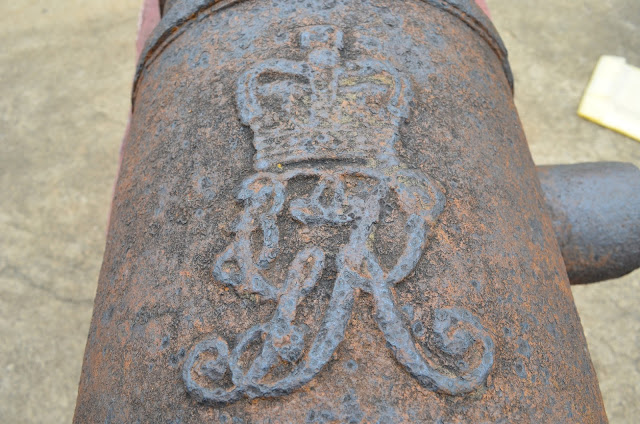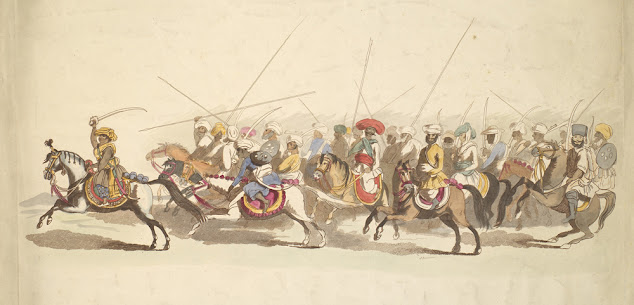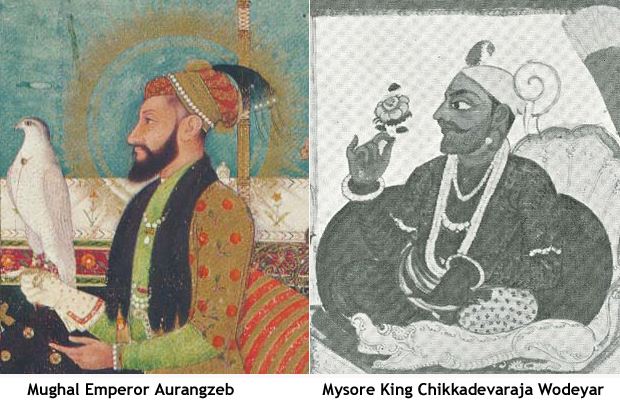How Haidar Ali and Tipu Sultan's Mysore Kingdom overcame Britain’s industrial revolution war inventions
Research and Author: Ameen Ahmed  |
| A British era cannon at Darya Daulat Bagh, Srirangapatna, southern Indian, the capital of Mysore Kingdom for many centuries until 1799. Pic: Author |
An 18th century Atlantic slavery relic in Karnataka
In September 2016, I was guiding a Canadian visitor through the palace and ruins of Srirangapatna. Among the many relics of British rule over India are the cannons one can see at many places like Srirangapatna, the erstwhile capital of Mysore Kingdom. At Darya Daulat Bagh, the summer palace of Mysore ruler Tipu Sultan, a couple of cannons have a curious GR mark engraved on their first reinforce (the part of the cannon that follows the vent). 18th century British cannons had certain words and numbers engraved on them. Among other things these coded engravings reveal the foundry where the cannon was cast or the person who owned that foundry as well as weight of the cannon barrel, size of the cannon ball it fired and name of the king who reigned over Great Britain during its manufacture. I learnt that the GR represents Georgious Rex- King George’s name in Latin (1). The cannons at Srirangapatna have numerical 2 or 3 etched inside these engravings. While the 2 represents King George II who reigned from 1727 until 1760, 3 stands for King George III who reigned from 1760 until 1820. Apart from GR3 one cannon at the entrance to Tipu Sultan's wooden summer palace at Darya Daulat Bagh has Solid Bacon engraved on its base ring (the part of cannon after the cascable, the pointed end where the cannon operator stands), which is the manufacturer’s name. My curiosity in understanding the manufacturer of this cannon led me to its probable origin- 18th century Atlantic slavery.
In September 2016, I was guiding a Canadian visitor through the palace and ruins of Srirangapatna. Among the many relics of British rule over India are the cannons one can see at many places like Srirangapatna, the erstwhile capital of Mysore Kingdom. At Darya Daulat Bagh, the summer palace of Mysore ruler Tipu Sultan, a couple of cannons have a curious GR mark engraved on their first reinforce (the part of the cannon that follows the vent). 18th century British cannons had certain words and numbers engraved on them. Among other things these coded engravings reveal the foundry where the cannon was cast or the person who owned that foundry as well as weight of the cannon barrel, size of the cannon ball it fired and name of the king who reigned over Great Britain during its manufacture. I learnt that the GR represents Georgious Rex- King George’s name in Latin (1). The cannons at Srirangapatna have numerical 2 or 3 etched inside these engravings. While the 2 represents King George II who reigned from 1727 until 1760, 3 stands for King George III who reigned from 1760 until 1820. Apart from GR3 one cannon at the entrance to Tipu Sultan's wooden summer palace at Darya Daulat Bagh has Solid Bacon engraved on its base ring (the part of cannon after the cascable, the pointed end where the cannon operator stands), which is the manufacturer’s name. My curiosity in understanding the manufacturer of this cannon led me to its probable origin- 18th century Atlantic slavery.
 |
| The mark GR3 denotes Georgius Rexus 3, the Latin name for King George III, the ruler of England when this cannon was made. Pic: Author |
Slavery and Industrial Revolution cannons
Chris Evans in his book Slave Wales (2) traces the origin, extent and benefactors of the Atlantic slave trade. He throws light on the connection between the name Bacon and cannons manufactured in Great Britain’s Wales and procured by the British East India Company. This probably decodes Solid Bacon on the above cannon in Srirangapatna.
Chris Evans in his book Slave Wales (2) traces the origin, extent and benefactors of the Atlantic slave trade. He throws light on the connection between the name Bacon and cannons manufactured in Great Britain’s Wales and procured by the British East India Company. This probably decodes Solid Bacon on the above cannon in Srirangapatna.
 |
| 'Bacon Solid' engraved on the iron cannon suggests it was manufactured by Anthony Bacon, an Atlantic slave trader. Pic: Author |
In 1758, during the Seven Years War between French & British (1756-63), the British captured many forts from French on the Senegal coast in Africa. Anthony Bacon, a Welsh businessman, bagged Government contract to supply food to these forts that stored slaves for transport to Americas brought from African hinterland (3). After emptying the cargo at these forts the ships transported slaves to the British Islands in the Caribbean for forced labour. Post Seven Years’ War Bacon was deeply involved in the trans-Atlantic slave trade- winning Government contracts to procure Black slaves from African hinterland and sail them from West African coast to have them sold into forced labour in the Caribbean. With the money earned from the slave trade Bacon delved into politics becoming an English Member of Parliament in 1764, which he was till his death. He was flush with slavery money at a time when technologists in this conglomerate of west European nations were innovating new ways to smelt iron. On being approached by Dr. William Brownrigg, a scientist and an expert in coal and iron mining, he wasted no time in purchasing iron mines in Wales in 1765. Though Coke-smelting technology was developed by Abraham Darby at Coalbrookdale in 1709, its growth in Britain was not rapid until capitalists like Bacon invested in it. Brownrigg’s brother in law Charles Wood was a blast furnace expert who invented the Pot and Stamping Method a new coal-fired refining technique that resulted in higher refinement of iron. In 1766 Bacon partnered with Brownrigg for a state of the art furnace at Cyfarthfa, which Wood constructed for them. For the first time this revolutionary production technique of iron was implemented where coke smelting and coal-fuelled refining were brought together in a single, integrated unit. A cannon foundry was added at the forge taking advantage of the high quality iron produced there. As Britain entered the Seven Years War it felt the need for more guns. The Board of Ordnance, which commissioned military guns in Britain was looking beyond its traditional suppliers. Given his connections and political background, Bacon won contracts and soon became the biggest supplier of cannons to the British Government.
 |
| Slave Market memorial at Stone Town, Zanzibar Island, Tanzania. Pic: Author |
According to Evans, Bacon received orders for 195 guns in April 1775. As residents of British colonies in America revolted against the British setting stage for America’s war of independence, Bacon received orders to supply 561 artillery pieces in 1778 and an additional 396 the next year. All of this came from Bacon’s cannon foundry and boring mill at Cyfarthfa. Interestingly Bacon also supplied cannons to the East India Company from the same foundry. By 1780 the foundry’s success prompted Bacon to source extra pig iron and also buy Plymouth works of which he was a partner of Isaac Wilkinson since 1766. In the same year he also leased the Hirwaun works including its iron and coal mines. Bacon's investment led Britain into the forefront of industrial revolution.
The Indo-English arms race of 18th century
In 1774 John, Isaac Wilkinson’s son, essentially patented the same cannon founding technique- boring of cannons 'from the solid'. Until then guns were produced by casting them around a central core which was removed after the metal around it solidified. The guns thereby produced were sometimes ineffective and also dangerous to handle due to the air pockets which would gather around the removable core. This new method cast a solid cannon as a single metal piece and then bored it by moving the barrel along a fixed blade. It eliminated weaknesses of the earlier standard gun production. The Board of Ordnance tested the guns produced by Wilkinson for Bacon and were impressed by its improved compactness and durability. Wilkinson’s patent was annulled some time later and Bacon set up his own cannon foundry using the technique. While the first word in Bacon Solid engraved on the cannon at Darya Daulat Bagh refers to Anthony Bacon, the second word Solid probably refers to the technique of casting the cannon as a single solid piece of iron.
Back in India, 19th century British historian Wilks (5) notes that musket matchlocks were the only fire arms used by the Mysore Army until 1750s. MCConnel claims the French like other Europeans were aware of the Maritz technology of boring from the solid. Given the close ties between French and Mysore under Haidar-Tipu, it is probable that contemporary European technology was also available to Mysoreans. In fact J.M.Mathew a young British officer who was participated in the British siege of Bangalore in March 1791 during the 3rd Anglo Mysore War wrote about a cannon boring machine of French construction and a French Chief Engineer being captured by the British from Bangalore fort (6). There is also a possibility of Mysoreans learning British technology from weapons captured in battles. Mysoreans captured the first ever canon from British when Haidar Ali defeated Col. Wood at Mulabagilu (Mulbagal) in Kolar District in the First Anglo Mysore War in late 1760s. (6)
But something remarkable happened in between. On 10 September 1780, at Pollilur, volleys of these decimated British troops led by the unfortunate Colonel Baillie. According to Lewin B Bowring (7) the British force was 3,700 strong and over 700 Europeans killed. The rest including Baillie himself, as well as Sir David Baird, were made prisoners of war. According to historian Nidhin George Olikara who has a special interest in Mysorean rockets, this was the first known instance of iron-cased rockets being used in warfare and they were a precursor to modern day rockets (8). Within two decades of Haidar Ali taking over the kingdom’s military Mysoreans produced the world’s first iron cased rockets. At that moment in history the Mysorean (present day Karnataka) research of applied chemistry, physics and math and their combined effect on human biology in a battle field was ahead of England’s industrial revolution knowledge of the same.
East India Company was engaged in a do-or-die battle with colonial and native powers in Indian subcontinent with full-fledged military involvement kicking off in the 1750s. But the names of two of their enemies reverberated not just in Europe but even in far off America. Between 1760 and 1799 Haidar Ali and Tipu Sultan, the father-son rulers of Mysore became synonymous with resistance against British colonialism, with horses and ships being named after these Mysorean warriors in Britain and further away in America. In their quest for supremacy both British and Haidar-Tipu not only sought alliances with the enemies of each other but also invested in cutting edge technology. In his study on the British Smooth-Bore Artillery at National Historic Parks in Canada (4), David MCConnell writes "Jan Verbruggen, a Dutch Master Gunfounder built a new horizontal boring machine over a period of three years with Johann Jacob Spiegler that could carve a canon cast in solid. It is said to have been inspired from the Maritz machine at Douai. He is said to have brought knowledge of this boring from solid technique with him when he was made the master founder in 1770 of Royal Brass Foundry at Woolwich and built an exclusive machine to manufacture cannons".
 |
| 'Rocket Warfare', by Charles H. Hubbell (1898–1971) captures the humiliation of British at the Battle of Pollilur (Sep. 1780) by Mysorean war rockets. |
Bacon died in 1786, but his cannon foundries continued to manufacture guns. By 1803 the Cyfarthfa foundry that he founded became the world’s largest employing 1,500 people. Britain officially abolished slavery in its colonies in 1807. But it continued to harvest benefits from this inhuman practise for quite some time afterward.
Ironically Britain ended slavery in east Africa's Zanzibar
Earlier in June, of that year, I stood at the beach beside Kalele Square at the edge of Stone Town, a UNESCO World heritage site. Located on the western side of Unjuga Island, popularly known as Zanzibar, one can enjoy breathtaking azure waters and clear blue skies. It was June and I could see the beautiful Prisoner’s Island surrounded by golden sand spits that appeared and disappeared with the tide. But the serenity quickly gave way to a frown as Robin, my tour guide explained that ‘Kalele’ in Swahili meant screams. East Africans produce a loud sound by twisting their tongue, to celebrate or mourn. Enslaved Blacks were transported from interior Africa and brought to the staging points on the mainland’s coast and also the nearby islands. Kalele square was one such place where the captured men, women and children were loaded onto boats to be transported to nearby ships before their long journey to far-away lands to work as forced labour. And as they were taken to these boats they would shriek or ‘Kalele’ in despair lamenting over their uncertain future not knowing even if they would arrive alive at their destination.
Earlier in June, of that year, I stood at the beach beside Kalele Square at the edge of Stone Town, a UNESCO World heritage site. Located on the western side of Unjuga Island, popularly known as Zanzibar, one can enjoy breathtaking azure waters and clear blue skies. It was June and I could see the beautiful Prisoner’s Island surrounded by golden sand spits that appeared and disappeared with the tide. But the serenity quickly gave way to a frown as Robin, my tour guide explained that ‘Kalele’ in Swahili meant screams. East Africans produce a loud sound by twisting their tongue, to celebrate or mourn. Enslaved Blacks were transported from interior Africa and brought to the staging points on the mainland’s coast and also the nearby islands. Kalele square was one such place where the captured men, women and children were loaded onto boats to be transported to nearby ships before their long journey to far-away lands to work as forced labour. And as they were taken to these boats they would shriek or ‘Kalele’ in despair lamenting over their uncertain future not knowing even if they would arrive alive at their destination.
 |
| The beach at Kalele square in Zanzibar, Tanzania, East African coast. Pic by author. |
Walking for a few hundred metres through the narrow alleys we saw spiked wooden doors whose designs were inspired by doors of India’s forts, passed by home of famous singer British Freddie Mercury, the landmark slave memorial, the 18th century fort of Arabs and also the home of Tippu Tib a most prominent slave trader here in 19th century. We then came across the king’s palace bang opposite the Zanzibar port. A little over 200 years ago British war ships parked near the coastline fired volleys of cannon shots to bring about one of the quickest naval war victories in modern history. The reason- British had abolished slave trade in 1807 and wanted Arab ruler of Zanzibar to end the same as well.
Sources and notes:(1) Meinert, Justin,. A Closer Look: An 18th Century Cannon, 2015. Downloaded on Aug. 25, 2019 from http://www.heinzhistorycenter.org/blog/fort-pitt-museum/a-closer-look-18th-century-cannon(2) Evans, Chris., Slave Wales: The Welsh and Atlantic Slavery, 1660 - 1850, 2010.(3) About Anthony Bacon: In 1730s, a teenager Anthony Bacon left Whitehaven, his birth place in England for the east coast of Maryland in America to trade in tobacco. At the store he owned he used slave labour. Slavery helped boost his business in 1740s and 50s. In 1757, George Washington, a slave owner who later became the president of United States contacted Anthony Bacon, to supply tobacco. Being an Englishman, Bacon had easier access to the British markets than Washington who was a resident of one of the British colonies.(4) McConnell, David., British smooth-bore artillery: A technological study to support identification, acquisition, restoration, reproduction, and interpretation of artillery at national historic parks in Canada. National Historic Parks and Sites, Environment Canada, Parks (1988).(5) Wilks, Mark., Historical Sketches of the South of India, Volume 1 of 3, 1810.(6) Matthew.J.M, Nine letters from a very young officer serving in India, under the Marquis Cornwallis, to his friend in Bengal, containing some particulars of the operations of the army, from the period of his Lordship's assuming the command to the capture of Bangalore. To which is added a slight sketch of its subsequent movements and transactions to the junction of the Marrattah Army on the twenty-eight of May, 1791, G.G.J. and J.Robinson, Paternoster-Row, London, 1793.(7) Bowring, Lewin B., Haidar Ali and Tipu Sultan and the struggle with the Musalman Powers of the South, 1893.(8) Personal communication in 2018.
~ ~ ~
ಈ ಬ್ಲಾಗನ್ನು ಕನ್ನಡಲ್ಲಿ ಓದುವುದಕ್ಕಾಗಿ ಇಲ್ಲಿ ಕ್ಲಿಕ್ ಮಾಡಿ
इस ब्लॉग को हिंदी में पड़ने के लिए यहाँ क्लिक करें
You may also like to read
Tipu Sultan and Haidar Ali, an inspiration for America’s founding fathers, revolutionaries and Confederate Congress
Hero, Tyrant or just another king? Shivaji's rule in Karnataka
Twenty six Hindu temples / towns attacked by Maratha soldiers along with Sringeri temple, in 1790 - 92 CE.
इस ब्लॉग को हिंदी में पड़ने के लिए यहाँ क्लिक करें
~ ~ ~
You may also like to read
Tipu Sultan and Haidar Ali, an inspiration for America’s founding fathers, revolutionaries and Confederate Congress
Hero, Tyrant or just another king? Shivaji's rule in Karnataka
Twenty six Hindu temples / towns attacked by Maratha soldiers along with Sringeri temple, in 1790 - 92 CE.





Comments
Post a Comment
Thank you for visiting this blog and sharing your thoughts.